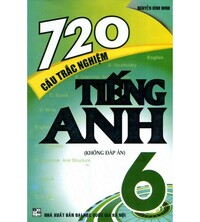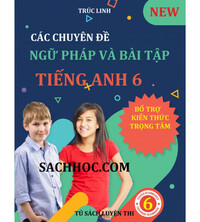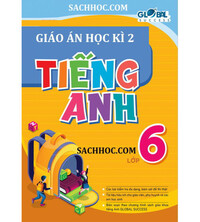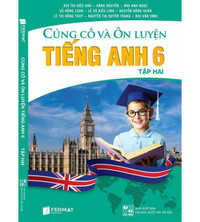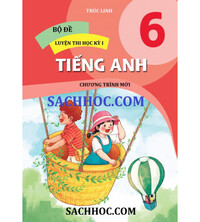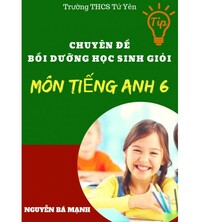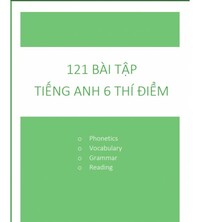Đề thi học kì 2 Tiếng Anh 6 iLearn Smart World - Đề số 5
I. Choose A, B, C or D to indicate the word whose underlined part differs from the other three in pronunciation in each of following question. II. Choose A, B, C or D to indicate the word that differs from in the other three in the position of primary stress in each following sentence. III. Choose the best answer. IV. Mark the letter A, B, C or D to indicate the underlined part that needs correction in each of the following.
Đề bài
I. Choose A, B, C or D to indicate the word whose underlined part differs from the other three in pronunciation in each of following question.
1.
A. southern
B. throw
C. another
D. bathe
2.
A. around
B. about
C. country
D. found
3.
A. terrible
B. comedy
C. president
D. general
II. Choose A, B, C or D to indicate the word that differs from in the other three in the position of primary stress in each following sentence.
4.
A. station
B. bottle
C. movie
D. donate
5.
A. wildlife
B. protect
C. purpose
D. useful
6.
A. action
B. drama
C. horror
D. arrive
III. Choose the best answer.
7. Astronauts __________have a shower in space because there is no gravity in space.
A. can
B. should
C. can’t
D. shouldn’t
8. In the future, people ___________ have driverless cars.
A. might
B. must C. can’t D. shouldn’t
9. You_______________ drive fast in the town centre.
A. can
B. should
C. can’t
D. shouldn’t
10. Minh didn’t do his homework, _______________ the teacher was angry with him.
A. so
B. but
C. and
D. or
11. There is no gravity,______astronauts must tie their sleeping bags to the wall.
A. so
B. but
C. and
D. or
12. She _________ they will live in a megacity.
A. think
B. to think
C. thinking
D. thinks
13. Do you think______ on the sea?
A. Mai lives
B. will Mai live
C. does Mai
D. Mai will live
14. This is the_____________ city in Vietnam.
A. beautiful
B. more beautiful
C. most beautiful
D. beautifulest
15. My bedroom is _______________ yours.
A. more comfortable
B. more comfortable than
C. the more comfortable
D. the most comfortable
16. If she ______ in bad light, she will ruin her eyes.
A. read
B. reading
C. to read
D. reads
17. I will get angry if you _______more mistakes.
A. make
B. will make
C. making
D. to make
18. If she travels to London, she_______ the museums.
A. visit
B. visits
C. visiting
D. will visit
19. She might _______to Greenwater Cave.
A. go
B. going
C. goes
D. to go
20. I think ______people will live in megacities.
A. lot of
B. lots
C. lots of
D. much
21. Will robots look __________ the elderly and children?
A. at
B. on
C. in
D. after
IV. Mark the letter A, B, C or D to indicate the underlined part that needs correction in each of the following.
22. I’d like eat lunch at home with my family.
A. eat
B. at
C. with
D. my family
23. Not use plastic bags to save our environment.
A. Not
B. bags
C. to
D. our
24. There is a clock at the wall in class.
A. is
B. a
C. at
D. in
25. Where is Susan? She is sitting next Jim.
A. Where
B. is
C. is
D. next
26. We is studying at Ha Noi University.
A. is
B. studying
C. at
D. University
V. Read the following passage and match the letter A, B, C or D on your answer sheet to indicate the correct word or phrase that best fits each of the numbered blanks.
Hide and seek is a (27) __________game that has been played for a long time. You can play it indoors or outdoors but the basic rules (28) __________the same. In this game, at least two players hide (29) __________ and one player, or "(31) __________", will find them. This game is quite (31) _________around the world and can be played by children or adults.
27.
A. children
B. child
C. children's
D. child's
28.
A. often are
B. are often
C. are not often
D. are often not
29.
A. themselves
B. theirs
C. them
D. their
30.
A. finder
B. hider
C. looker
D. seeker
31.
A. common
B. popular
C. usual
D. important
VI. Read the following passage and match the letter A, B, C or D on your answer sheet to indicate the correct answer to each of the following questions.
ELIZABETH 1: THE GOLDEN AGE
Friday Review by Scott Kerry
I watched the movie Elizabeth I: The Golden Age last Thursday with a group of friends. We watched it for a history project we're doing at school. It is a drama about Queen Elizabeth I. She was born in 1533 and became Queen of England in 1558. She was a really strong leader. Her ships won battles against Spanish ships in 1588. Before I watched it, I didn't know if I would like it. I don't like many dramas but this was fantastic. The story of the movie was really interesting and so many exciting things happened. It was great! All my friends loved it too. You really should watch it!
32. When did Scott watch the movie?
A. Thursday
B. Wednesday
C. Saturday
D. Sunday
33. Why did Scott watch the movie?
A. He likes dramas.
B. For a history project
C. His friends wanted to
D. His teacher wanted him
34. Who was Elizabeth I?
A. A Spanish Queen.
B. A movie
C. An English queen
D. A character
35. Why didn't Scott want to watch the movie?
A. He was busy.
B. He was with a group of friends.
C. He was excited about it.
D. He doesn't like many dramas.
36. What did Scott think about the movie?
A. It was boring B. It had an interesting story
C. He didn't like it D. It was terrible
VII. Rewrite the second sentence so that it has the same meaning as the first one.
37. It’s necessary for you to bring bottled water.
A. You need to bring bottled water.
B. You need bring a bottled water.
C. You needed to bring a bottled water.
D. You were need bring a bottled water.
38. Nobody in my family is older than my grandfather.
A. My grandfather is older than anyone.
B. My grandfather is the oldest person in my family.
C. My grandfather is the oldest person.
D. My grandfather is as old as everyone.
39. I think Math is more difficult than Chemistry.
A. I think Chemistry is as difficult as Math.
B. I think Chemistry is more easy than Math.
C. I think Chemistry is as easy as Math.
D. I think Chemistry is easier than Math.
40. Don't pick flowers in the park.
A. You can't pick flowers in the park.
B. You don’t have to pick flowers in the park.
C. You mustn’t pick flowers in the park.
D. You won’t pick flowers in the park.
--------------------THE END--------------------
Đáp án
HƯỚNG DẪN GIẢI
Thực hiện: Ban chuyên môn

HƯỚNG DẪN GIẢI CHI TIẾT
1. B
Kiến thức: Phát âm “th”
Giải thích:
A. southern /ˈsʌðən/
B. throw /θrəʊ/
C. another /əˈnʌðə(r)/
D. bathe /beɪð/
Phần được gạch chân ở phương án B được phát âm /θ/, các phương án còn lại phát âm /ð/.
Đáp án B
2. C
Kiến thức: Phát âm “ou”
Giải thích:
A. around /əˈraʊnd/
B. about /əˈbaʊt/
C. country /ˈkʌntri/
D. found /faʊnd/
Phần được gạch chân ở phương án C được phát âm /ʌ/, các phương án còn lại phát âm /aʊ/.
Đáp án C
3. B
Kiến thức: Phát âm “e”
Giải thích:
A. terrible /ˈterəbl/
B. comedy /ˈkɒmədi/
C. president /ˈprezɪdənt/
D. general /ˈdʒenrəl/
Phần được gạch chân ở phương án B được phát âm /ə/, các phương án còn lại phát âm /e/.
Đáp án B
4. D
Kiến thức: Trọng âm từ có 2 âm tiết
Giải thích:
A. station (n) /ˈsteɪʃn/
B. bottle (n) /ˈbɒtl/
C. movie (n) /ˈmuːvi/
D. donate (v) /dəʊˈneɪt/
Phương án D có trọng âm 2, các phương án còn lại có trọng âm 1.
Đáp án D
5. B
Kiến thức: Trọng âm từ có 2 âm tiết
Giải thích:
A. wildlife (n) /ˈwaɪldlaɪf/
B. protect (v) /prəˈtekt/
C. purpose (n) /ˈpɜːpəs/
D. useful (adj) /ˈjuːsfl/
Phương án B có trọng âm 2, các phương án còn lại có trọng âm 1.
Đáp án B
6. D
Kiến thức: Trọng âm từ có 2 âm tiết
Giải thích:
A. action (n) /ˈækʃn/
B. drama (n) /ˈdrɑːmə/
C. horror (n) /ˈhɒrə(r)/
D. arrive (v) /əˈraɪv/
Phương án D có trọng âm 2, các phương án còn lại có trọng âm 1.
Đáp án D
7. C
Kiến thức: Động từ khuyết thiếu
Giải thích:
A. can: có thể
B. should: nên
C. can’t: không thể
D. shouldn’t: không nên
Astronauts can’t have a shower in space because there is no gravity in space.
(Phi hành gia không thể tắm ở ngoài không gian bởi vì không có trọng lực ở ngoài không gian.)
Đáp án C
8. A
Kiến thức: Động từ khuyết thiếu
Giải thích:
Dùng cấu trúc: “might + Vinf” để diễn tả một dự đoán về tương lai
In the future, people might have driverless cars.
(Ở tương lai, con người có thể có ô tô không người lái.)
Đáp án A
9. D
Kiến thức: Động từ khuyết thiếu
Giải thích:
A. can: có thể
B. should: nên
C. can’t: không thể
D. shouldn’t: không nên
You shouldn’t drive fast in the town centre.
(Bạn không nên lái xe nhanh ở trung tâm thị trấn.)
Đáp án D
10. A
Kiến thức: Liên từ
Giải thích:
A. so: nên
B. but: nhưng
C. and: và
D. or: hoặc
Minh didn’t do his homework, so the teacher was angry with him.
(Minh đã không làm bài tập về nhà, vì vậy giáo viên đã rất tức giận với cậu ấy.)
Đáp án A
11. A
Kiến thức: Liên từ
Giải thích:
A. so: nên
B. but: nhưng
C. and: và
D. or: hoặc
There is no gravity, so astronauts must tie their sleeping bags to the wall.
(Không có trọng lực, vì vậy những phi hành gia phải buộc túi ngủ của mình lên tường.)
Đáp án A
12. D
Kiến thức: Thì hiện tại đơn
Giải thích:
Chủ ngữ số ít “she” => động từ thường “think” cần chia
She thinks they will live in a megacity.
(Cô ấy nghĩ rằng họ sẽ sống ở những siêu đô thị.)
Đáp án D
13. D
Kiến thức: Thì tương lai đơn
Giải thích:
Cấu trúc: S think(s) + S + will + Vinf dùng để nên ra ý kiến về tương lai
Do you think Mai will live on the sea?
(Bạn có nghĩ rằng Mai sẽ sống ở vùng biển không?)
Đáp án D
14. C
Kiến thức: So sánh nhất
Giải thích:
Dấu hiệu “the”. Cấu trúc: S + be/V + the adj-est/ most adj + N + (in a group).
This is the most beautiful city in Vietnam.
(Đây là thành phố đẹp nhất Việt Nam.)
Đáp án C
15. B
Kiến thức: So sánh hơn
Giải thích:
Cấu trúc: S1 + be/V + adj-er/ more adj + than + S2.
My bedroom is more comfortable than yours.
(Phòng ngủ của tôi thoải mái hơn của bạn.)
Đáp án B
16. D
Kiến thức: Câu điều kiện loại 1
Giải thích:
Cách dùng: Diễn tả một giả thuyết có khả năng xảy ra ở hiện tại/ tương lai
Cấu trúc: If + S + V(HTĐ), S will/can/may + Vinf.
If she reads in bad light, she will ruin her eyes.
(Nếu cô ấy đọc sách ở nơi ánh sáng không tốt, cô ấy sẽ làm hại mắt.)
Đáp án D
17. A
Kiến thức: Câu điều kiện loại 1
Giải thích:
Cách dùng: Diễn tả một giả thuyết có khả năng xảy ra ở hiện tại/ tương lai
Cấu trúc: S + will/can/may + Vinf + if + S + V(HTĐ)
I will get angry if you make more mistakes.
(Tôi sẽ bực mình nếu bạn mắc thêm nhiều lỗi.)
Đáp án A
18. D
Kiến thức: Câu điều kiện loại 1
Giải thích:
Cách dùng: Diễn tả một giả thuyết có khả năng xảy ra ở hiện tại/ tương lai
Cấu trúc: If + S + V(HTĐ), S will/can/may + Vinf.
If she travels to London, she will visit the museums.
(Nếu cô ấy đi tới London, cô ấy sẽ thăm các bảo tàng.)
Đáp án D
19. A
Kiến thức: Động từ
Giải thích:
Cấu trúc: might + Vinf: dùng để diễn tả dự đoán về tương lai
She might go to Greenwater Cave.
(Cô ấy có thể đi tới Động Greenwater.)
Đáp án A
20. C
Kiến thức: Lượng từ
Giải thích:
Dùng: a lot of = lots of + danh từ số nhiều; “people” là danh từ đếm được, số nhiều
I think lots of people will live in megacities.
(Tôi nghĩ nhiều người sẽ sống ở các siêu đô thị.)
Đáp án C
21. D
Kiến thức: Cụm động từ
Giải thích:
A. look at: nhìn vào
B. look on: đứng ngoài nhìn/ xem
C. look in: đến thăm một người trong thời gian ngắn
D. look after: chăm sóc
Will robots look after the elderly and children?
(Rô-bốt sẽ chăm sóc người già và trẻ em chứ?)
Đáp án D
22. A
Kiến thức: V-ing/ to Vinf
Giải thích:
Cấu trúc: would like to Vinf: thích làm gì
Sửa: eat => to eat
I’d like to eat lunch at home with my family.
(Tôi thích ăn trưa ở nhà cùng gia đình.)
Đáp án A
23. A
Kiến thức: Mệnh lệnh thức
Giải thích:
Cấu trúc: V!/ Don’t V! dùng để yêu cầu/ khuyên ai làm gì
Sửa: Not => Do not/ Don’t
Don’t use plastic bags to save our environment.
(Không dùng túi ni-lông để bảo vệ môi trường.)
Đáp án A
24. C
Kiến thức: Giới từ
Giải thích:
Cụm “on the wall” (ở trên tường)
Sửa: at => on
There is a clock on the wall in class.
(Có một cái đồng hồ ở trên tường trong lớp.)
Đáp án C
25. D
Kiến thức: Giới từ
Giải thích:
next to: sát cạnh
Sửa: next => next to
Where is Susan? She is sitting next to Jim.
(Susan ở đâu? - Cô ấy đang ngồi cạnh Jim.)
Đáp án D
26. A
Kiến thức: Sự hòa hợp chủ ngữ - động từ
Giải thích:
Chủ ngữ số nhiều “We” đi kèm động từ tobe “are”
Sửa: is => are
We are studying at Ha Noi University.
(Chúng tôi đang học ở trường Đại học Hà Nội.)
Đáp án A
27. C
Kiến thức: Từ vựng
Giải thích:
A. children: trẻ em
B. child: một đứa trẻ
C. children’s: của trẻ em
D. child’s: của một đứa trẻ
Hide and seek is a children’s game that has been played for a long time.
(Trốn tìm là một trò chơi trẻ con đã được chơi trong một khoảng thời gian dài.)
Đáp án C
28. B
Kiến thức: Vị trí trạng từ chỉ tần suất
Giải thích:
Vị trí của trạng từ chỉ tần suất: đứng sau động từ tobe
You can play it indoors or outdoors, but the basic rules are often the same.
(Bạn có thể chơi nó trong nhà hoặc ngoài trời nhưng các quy tắc cơ bản thường giống nhau.)
Đáp án B
29. A
Kiến thức: Đại từ phản thân
Giải thích:
S + V + oneself: Ai đó tự làm gì; chủ ngữ số nhiều “two players” => đại từ phản thân “themselves”
In this game, at least two players hide (29) themselves…
(Trong trò chơi này, ít nhất hai người chơi tự đi trốn)
Đáp án A
30. D
Kiến thức: Từ vựng
Giải thích:
A. finder: người tìm
B. hider: người trốn
C. looker: người nhìn
D. seeker: người đi tìm
In this game, at least two players hide themselves and one player, or "(30) seeker ", will find them.
(Trong trò chơi này, ít nhất hai người chơi tự trốn và một người chơi khác, hoặc "người tìm kiếm", sẽ tìm thấy họ.)
Trò chơi “hide-and-seek” => người đi tìm “seeker”
Đáp án D
31. B
Kiến thức: Từ vựng
Giải thích:
A. common (adj): quen thuộc
B. popular (adj): phổ biến
C. usual (adj): thông thường
D. important (adj): quan trọng
This game is quite (31) popular around the world and can be played by children or adults.
(Trò chơi này khá phổ biến trên toàn thế giới và trẻ em hoặc người lớn đều có thể chơi được.)
Đáp án B
Bài đọc hoàn chỉnh:
Hide and seek is a (27) children's game that has been played for a long time. You can play it indoors or outdoors but the basic rules (28) are often the same. In this game, at least two players hide (29) themselves and one player, or "(30) seeker ", will find them. This game is quite (31) popular around the world and can be played by children or adults.
Tạm dịch bài đọc:
Trốn tìm là một trò chơi của trẻ em đã xuất hiện từ rất lâu. Bạn có thể chơi trong nhà hoặc ngoài trời nhưng luật chơi cơ bản vẫn giống nhau. Trong trò chơi này, có ít nhất hai người chơi tìm cách trốn và một người, hay “người đi tìm”, sẽ đi tìm họ. Trò chơi khá phổ biến trên thế giới và cả trẻ em lẫn người lớn đều chơi được.
32. A
Kiến thức: Đọc hiểu
Giải thích:
Scott đã xem bộ phim khi nào?
A. thứ Năm
B. thứ Tư
C. thứ Bảy
D. Chủ nhật
Thông tin: I watched the movie Elizabeth I: The Golden Age last Thursday with a group of friends.
(Tôi đã xem bộ phim “Elizabeth I: The Golden Age” vào thứ năm tuần trước cùng một nhóm bạn.)
Đáp án A
33. B
Kiến thức: Đọc hiểu
Giải thích:
Tại sao Scott lại xem bộ phim?
A. Cậu ấy thích thể loại phim chính kịch.
B. Cho một dự án môn lịch sử.
C. Các bạn cậu ấy muốn
D. Giáo viên muốn cậu xem
Thông tin: We watched it for a history project we're doing at school.
(Chúng tôi xem vì một dự án môn lịch sử ở trường.)
Đáp án B
34. C
Kiến thức: Đọc hiểu
Giải thích:
Elizabeth đệ nhất là ai?
A. Nữ hoàng Tây Ban Nha
B. Một bộ phim
C. Nữ hoàng Anh
D. Một nhân vật
Thông tin: It is a drama about Queen Elizabeth I. She was born in 1533 and became Queen of England in 1558.
(Đó là một bộ phim chính kịch về nữ hoàng Elizabeth đệ nhất. Bà sinh năm 1533 và trở thành nữ hoàng nước Anh vào năm 1558.)
Đáp án C
35. D
Kiến thức: Đọc hiểu
Giải thích:
Tại sao ban đầu Scott không muốn xem bộ phim này?
A. Cậu ây bận.
B. Cậu đã ở cùng một nhóm bạn.
C. Cậu đã rất hào hứng về nó.
D. Cậu ấy không thích nhiều bộ phim chính kịch.
Thông tin: Before I watched it, I didn't know if I would like it. I don't like many dramas
(Trước khi xem, tôi không biết là mình có thích không. Tôi không thích nhiều bộ phim chính kịch)
Đáp án D
36. B
Kiến thức: Đọc hiểu
Giải thích:
Scott nghĩ gì về bộ phim?
A. Nó rất chán.
B. Nó có một câu chuyện thú vị.
C. Cậu đã không thích nó.
D. Nó rất tệ.
Thông tin: The story of the movie was really interesting and so many exciting things happened.
(Câu chuyện bộ phim thật sự thú vị và nhiều chuyện lý thú đã xảy ra.)
Đáp án B
Tạm dịch bài đọc:
ELIZABETH ĐỆ NHẤT: THỜI ĐẠI HOÀNG KIM
Đánh giá vào ngày Thứ sáu bởi Scott Kerry
Tôi đã xem bộ phim “Elizabeth I: The Golden Age” vào thứ năm tuần trước cùng một nhóm bạn. Chúng tôi xem vì một dự án môn lịch sử ở trường. Đó là một bộ phim chính kịch về nữ hoàng Elizabeth đệ nhất. Bà sinh năm 1533 và trở thành nữ hoàng nước Anh vào năm 1558. Bà là một nữ vương mạnh mẽ. Tàu chiến của bà đã chiến thắng đội quân Tây Ban Nha vào năm 1588. Trước khi xem, tôi không biết là mình có thích không. Tôi không thích nhiều bộ phim chính kịch nhưng bộ phim này quá tuyệt. Câu chuyện bộ phim thật sự thú vị và nhiều chuyện lý thú đã xảy ra. Nó thật tuyệt! Tất cả các bạn tôi cũng yêu thích bộ phim này. Bạn rất nên xem nó.
37. A
Kiến thức: Cấu trúc câu tương đương
Giải thích:
Cấu trúc: It’s necessary (for somebody) to Vinf = S need to Vinf
Các đáp án B, C, D sai cấu trúc/ sai thì.
It’s necessary for you to bring a bottled water.
(Cần thiết cho bạn để mang theo nước đóng chai.)
= You need to bring bottled water.
(Bạn cần mang theo nước đóng chai.)
Đáp án A
38. B
Kiến thức: So sánh hơn – so sánh nhất
Giải thích:
Cấu trúc so sánh nhất: S + be/V + the adj-est/ most adj + N + (in a group).
Nobody in my family is older than my grandfather.
(Không ai trong gia đình tôi già hơn ông. )
= My grandfather is the oldest person in my family.
(Ông là người cao tuổi nhất trong gia đình tôi.)
Đáp án B
39. D
Kiến thức: So sánh hơn – so sánh bằng
Giải thích:
I think Math is more difficult than Chemistry.
(Tôi nghĩ Toán khó hơn Hóa học. )
A. Tôi nghĩ Hóa học khó như Toán.
B. sai ngữ pháp
C. Tôi nghĩ Hóa học dễ như Toán.
D. Tôi nghĩ Hóa học dễ hơn Toán.
Đáp án D
40. C
Kiến thức: Cấu trúc câu tương đương
Giải thích:
Cấu trúc: Do not Vinf = S + mustn’t Vinf: (Ai đó) không được phép làm gì
Don't pick flowers in the park.
(Đừng hái hoa trong công viên.)
A. Bạn không thể hái hoa trong công viên.
B. Bạn không cần phải hái hoa trong công viên.
C. Bạn không được phép hái hoa trong công viên.
D. Bạn sẽ không hái hoa trong công viên.
Đáp án C
Search google: "từ khóa + timdapan.com" Ví dụ: "Đề thi học kì 2 Tiếng Anh 6 iLearn Smart World - Đề số 5 timdapan.com"
